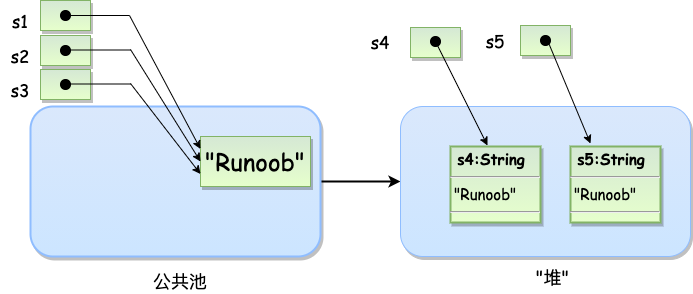创建字符串
- 最简单的创建字符串方法:
String str = "Runoob";
- 用构造函数创建字符串:
String str2 = new String("Runoob");
String创建的字符串存储在公共池中,而new创建的字符串对象在堆上:
String s1 = "Runoob"; // String 直接创建String s2 = "Runoob"; // String 直接创建String s3 = s1; // 相同引用String s4 = new String("Runoob"); // String 对象创建String s5 = new String("Runoob"); // String 对象创建

String 类有 11 种构造方法,这些方法提供不同的参数来初始化字符串,比如提供一个字符数组参数: ```java public class StringDemo{ public static void main(String args[]){
char[] helloArray = { 'r', 'u', 'n', 'o', 'o', 'b'};String helloString = new String(helloArray);System.out.println( helloString );
} }
//run runoob
**注意:**String 类是不可改变的,所以你一旦创建了 String 对象,那它的值就无法改变了---<a name="IaBtX"></a>## 字符串长度- String类的一个访问器方法是length()方法,他返回的字符串对象包含的字符数。```javapublic class StringDemo{public static void main(String[] args){String stie = "www.runoob.com";int len = site.length();System.out.println("长度为:" + len);}}-----------------------------------------//run长度为:14
连接字符串
- String类提供了连接两个字符串的方法:
string1.concat(string2);
- 返回string2连接string1的新字符串。也可以对字符串常量使用concat()方法。
"我叫".concat("Runoob");
- 常用使用”+”来连接字符串
"Hello" + "Wrold";
创建格式化字符串
我们知道输出格式化数字可以使用 printf() 和 format() 方法。
String 类使用静态方法 format() 返回一个String 对象而不是 PrintStream 对象。
String 类的静态方法 format() 能用来创建可复用的格式化字符串,而不仅仅是用于一次打印输出。
System.out.printf("浮点型变量的值为 " +"%f, 整型变量的值为 " +" %d, 字符串变量的值为 " +"is %s", floatVar, intVar, stringVar);-------------------------------------------orString fs;fs = String.format("浮点型变量的值为 " +"%f, 整型变量的值为 " +" %d, 字符串变量的值为 " +" %s", floatVar, intVar, stringVar);
String 方法
| SN(序号) | 方法描述 |
|---|---|
| 1 | char charAt(int index) |
返回指定索引处的 char 值。 | | 2 | int compareTo(Object o)
把这个字符串和另一个对象比较。 | | 3 | int compareTo(String anotherString)
按字典顺序比较两个字符串。 | | 4 | int compareToIgnoreCase(String str)
按字典顺序比较两个字符串,不考虑大小写。 | | 5 | String concat(String str)
将指定字符串连接到此字符串的结尾。 | | 6 | boolean contentEquals(StringBuffer sb)
当且仅当字符串与指定的StringBuffer有相同顺序的字符时候返回真。 | | 7 | static String copyValueOf(char[] data)
返回指定数组中表示该字符序列的 String。 | | 8 | static String copyValueOf(char[] data, int offset, int count)
返回指定数组中表示该字符序列的 String。 | | 9 | boolean endsWith(String suffix)
测试此字符串是否以指定的后缀结束。 | | 10 | boolean equals(Object anObject)
将此字符串与指定的对象比较。 | | 11 | boolean equalsIgnoreCase(String anotherString)
将此 String 与另一个 String 比较,不考虑大小写。 | | 12 | byte[] getBytes()
使用平台的默认字符集将此 String 编码为 byte 序列,并将结果存储到一个新的 byte 数组中。 | | 13 | byte[] getBytes(String charsetName)
使用指定的字符集将此 String 编码为 byte 序列,并将结果存储到一个新的 byte 数组中。 | | 14 | void getChars(int srcBegin, int srcEnd, char[] dst, int dstBegin)
将字符从此字符串复制到目标字符数组。 | | 15 | int hashCode()
返回此字符串的哈希码。 | | 16 | int indexOf(int ch)
返回指定字符在此字符串中第一次出现处的索引。 | | 17 | int indexOf(int ch, int fromIndex)
返回在此字符串中第一次出现指定字符处的索引,从指定的索引开始搜索。 | | 18 | int indexOf(String str)
返回指定子字符串在此字符串中第一次出现处的索引。 | | 19 | int indexOf(String str, int fromIndex)
返回指定子字符串在此字符串中第一次出现处的索引,从指定的索引开始。 | | 20 | String intern()
返回字符串对象的规范化表示形式。 | | 21 | int lastIndexOf(int ch)
返回指定字符在此字符串中最后一次出现处的索引。 | | 22 | int lastIndexOf(int ch, int fromIndex)
返回指定字符在此字符串中最后一次出现处的索引,从指定的索引处开始进行反向搜索。 | | 23 | int lastIndexOf(String str)
返回指定子字符串在此字符串中最右边出现处的索引。 | | 24 | int lastIndexOf(String str, int fromIndex)
返回指定子字符串在此字符串中最后一次出现处的索引,从指定的索引开始反向搜索。 | | 25 | int length()
返回此字符串的长度。 | | 26 | boolean matches(String regex)
告知此字符串是否匹配给定的正则表达式。 | | 27 | boolean regionMatches(boolean ignoreCase, int toffset, String other, int ooffset, int len)
测试两个字符串区域是否相等。 | | 28 | boolean regionMatches(int toffset, String other, int ooffset, int len)
测试两个字符串区域是否相等。 | | 29 | String replace(char oldChar, char newChar)
返回一个新的字符串,它是通过用 newChar 替换此字符串中出现的所有 oldChar 得到的。 | | 30 | String replaceAll(String regex, String replacement)
使用给定的 replacement 替换此字符串所有匹配给定的正则表达式的子字符串。 | | 31 | String replaceFirst(String regex, String replacement)
使用给定的 replacement 替换此字符串匹配给定的正则表达式的第一个子字符串。 | | 32 | String[] split(String regex)
根据给定正则表达式的匹配拆分此字符串。 | | 33 | String[] split(String regex, int limit)
根据匹配给定的正则表达式来拆分此字符串。 | | 34 | boolean startsWith(String prefix)
测试此字符串是否以指定的前缀开始。 | | 35 | boolean startsWith(String prefix, int toffset)
测试此字符串从指定索引开始的子字符串是否以指定前缀开始。 | | 36 | CharSequence subSequence(int beginIndex, int endIndex)
返回一个新的字符序列,它是此序列的一个子序列。 | | 37 | String substring(int beginIndex)
返回一个新的字符串,它是此字符串的一个子字符串。 | | 38 | String substring(int beginIndex, int endIndex)
返回一个新字符串,它是此字符串的一个子字符串。 | | 39 | char[] toCharArray()
将此字符串转换为一个新的字符数组。 | | 40 | String toLowerCase()
使用默认语言环境的规则将此 String 中的所有字符都转换为小写。 | | 41 | String toLowerCase(Locale locale)
使用给定 Locale 的规则将此 String 中的所有字符都转换为小写。 | | 42 | String toString()
返回此对象本身(它已经是一个字符串!)。 | | 43 | String toUpperCase()
使用默认语言环境的规则将此 String 中的所有字符都转换为大写。 | | 44 | String toUpperCase(Locale locale)
使用给定 Locale 的规则将此 String 中的所有字符都转换为大写。 | | 45 | String trim()
返回字符串的副本,忽略前导空白和尾部空白。 | | 46 | static String valueOf(primitive data type x)
返回给定data type类型x参数的字符串表示形式。 | | 47 | contains(CharSequence chars)
判断是否包含指定的字符系列。 | | 48 | isEmpty()
判断字符串是否为空。 |

